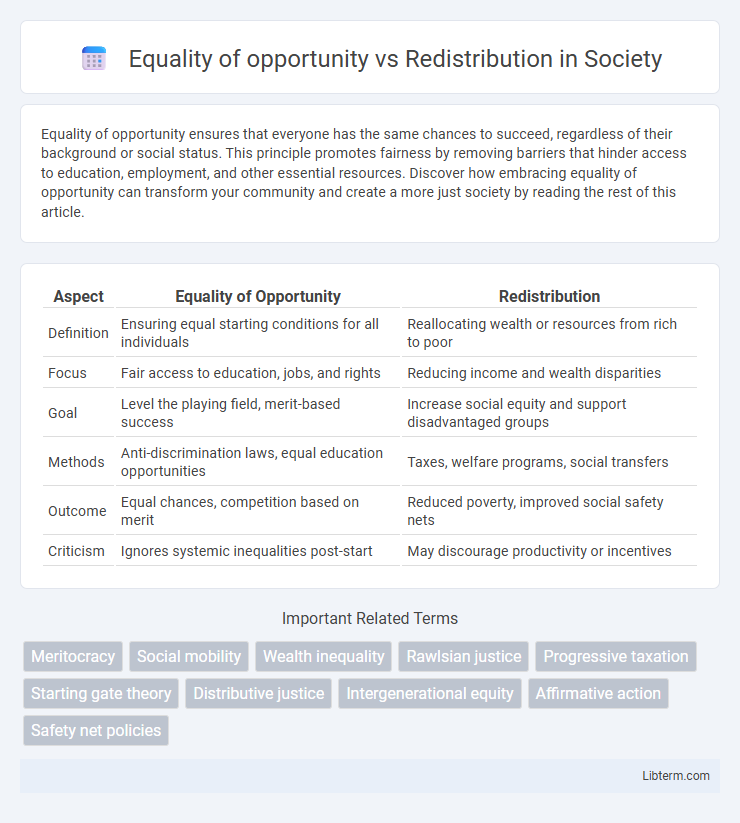Equality of opportunity ensures that everyone has the same chances to succeed, regardless of their background or social status. This principle promotes fairness by removing barriers that hinder access to education, employment, and other essential resources. Discover how embracing equality of opportunity can transform your community and create a more just society by reading the rest of this article.
Table of Comparison
| Aspect | Equality of Opportunity | Redistribution |
|---|---|---|
| Definition | Ensuring equal starting conditions for all individuals | Reallocating wealth or resources from rich to poor |
| Focus | Fair access to education, jobs, and rights | Reducing income and wealth disparities |
| Goal | Level the playing field, merit-based success | Increase social equity and support disadvantaged groups |
| Methods | Anti-discrimination laws, equal education opportunities | Taxes, welfare programs, social transfers |
| Outcome | Equal chances, competition based on merit | Reduced poverty, improved social safety nets |
| Criticism | Ignores systemic inequalities post-start | May discourage productivity or incentives |
Defining Equality of Opportunity
Equality of opportunity ensures all individuals have the same starting conditions to pursue life chances, emphasizing fair access to education, employment, and resources without discrimination. It contrasts with redistribution, which aims to adjust outcomes by reallocating wealth or resources to address social inequalities. Defining equality of opportunity centers on removing barriers and providing equal access rather than guaranteeing equal results.
Understanding Redistribution
Redistribution involves reallocating wealth and resources through mechanisms such as progressive taxation and social welfare programs to reduce economic inequality and promote social equity. Its goal is to provide a safety net and equalize access to essential services like education, healthcare, and housing for disadvantaged groups. Understanding redistribution requires analyzing its impact on economic mobility, social cohesion, and the balance between incentives and fairness in policy design.
Historical Perspectives on Economic Justice
Historical perspectives on economic justice reveal a persistent tension between equality of opportunity and redistribution, key themes in policy debates since the Industrial Revolution. Proponents of equality of opportunity emphasize meritocratic ideals, arguing for equal access to education and employment regardless of social background, as championed by thinkers like John Rawls in his theory of justice. Redistribution advocates, influenced by Marxist and social democratic traditions, highlight structural inequalities and endorse progressive taxation and welfare policies to address entrenched economic disparities.
Key Differences Between Opportunity and Redistribution
Equality of opportunity emphasizes creating a level playing field where individuals have the same chances to succeed based on merit, while redistribution focuses on reallocating resources to reduce economic disparities. Opportunity equality targets systemic barriers like education and employment access, whereas redistribution addresses income inequality through mechanisms such as taxation and welfare programs. The key difference lies in equality of opportunity fostering fairness through access, whereas redistribution enforces equity through financial adjustments.
Philosophical Foundations of Equality
Equality of opportunity emphasizes providing individuals with the same starting conditions to succeed based on merit, rooted in liberal philosophies that prioritize fairness and individual autonomy. Redistribution advocates for adjusting economic resources to achieve more equal outcomes, reflecting egalitarian principles that address systemic inequalities and social justice. Philosophical foundations debate whether justice lies in equal chances or equal results, with thinkers like Rawls supporting redistributive justice to ensure fairness beyond formal equality.
Policy Approaches: Opportunity vs Redistribution
Policy approaches to equality of opportunity emphasize removing barriers in education, employment, and legal frameworks to ensure all individuals can compete on a level playing field. Redistribution-focused policies prioritize reallocating income and resources through taxation and social welfare programs to reduce economic disparities directly. Balancing these approaches requires careful design to promote fairness while avoiding disincentives for productivity and innovation.
Advantages and Challenges of Equality of Opportunity
Equality of opportunity promotes fairness by ensuring individuals have the same starting point to succeed based on merit, fostering innovation and social mobility. It encourages personal responsibility and economic efficiency, as talents can be fully utilized without artificial barriers. However, challenges include persistent structural inequalities and unequal access to resources like quality education, which can limit true equal opportunities in diverse societies.
Economic and Social Impacts of Redistribution
Redistribution policies aim to reduce income inequality by reallocating wealth through progressive taxation and social welfare programs, which can enhance social mobility and access to essential services like education and healthcare. Economic impacts include increased consumer spending and poverty reduction, but potential drawbacks involve diminished incentives for productivity and investment. Socially, redistribution fosters greater social cohesion and reduces disparities, yet may also provoke debates over fairness and individual merit.
Balancing Opportunity and Redistribution in Practice
Balancing equality of opportunity and redistribution requires implementing policies that ensure fair access to education, healthcare, and employment while providing targeted financial support to marginalized groups. Progressive taxation systems combined with investments in social infrastructure can reduce systemic barriers without undermining incentives for innovation and productivity. Empirical evidence from Nordic countries demonstrates that integrating these approaches fosters social mobility and reduces income inequality effectively.
The Future of Fairness: Finding Common Ground
Equality of opportunity promotes a level playing field where individuals have the same chances to succeed, while redistribution addresses economic imbalances through policies like progressive taxation and social welfare programs. The future of fairness lies in integrating both approaches to create a society that supports equal access to education, healthcare, and employment while reducing poverty and income inequality. Finding common ground involves designing policies that enhance social mobility without disincentivizing productivity, ensuring sustainable economic growth and social justice.
Equality of opportunity Infographic

 libterm.com
libterm.com